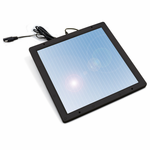Solar Photovoltaics in Small Model House
Tomorrow my daughter and I will spend the afternoon on a project for her science class at school: building a model house whose electrical power is delivered with solar photovoltaics. I have a small solar panel that (I believe) will put out about 5 Watts in the full sun, and a couple of flashlight batteries of different types. I think I’m going to have to experiment with series vs. parallel circuits, different bulbs, etc., before I get this right. Should be fun.


Check the design voltage of the panel. Voltage output of the panel needs to be higher than or equal to the charging voltage of the battery for the battery to be charged. Usually panels this size are rated at 18V and designed to trickle charge 12V batteries.
If the panel is for charging a 12V battery, get a cheap MR16 12V LED light to show the panel lighting up the model house. 18V will not harm the LED light.
If the panel is lower than 18V you could try getting individual LEDs which are usually rated for around 3.2volts each, and put several in series to make up the rated voltage of the panel i.e. 3 in series for a 9V rated panel. Ensure that the combined rated power of the LEDs exceeds the output of the panel as individual LEDs have no protective circuitry to prevent over voltage / over current failure.
I’m getting 22V from the panel, but I can’t seem to get anything to light up. I put two 7V flashlight bulbs in series, which I would have thought would work, but no.
22volts would be the open circuit voltage. When you put a load on the panel, the voltage drops. The higher the current you try to draw, the more the voltage will drop. If the load is too high, you will in effect stall the panel. I do not know the nominal wattage of the two flash light bulbs, but it may be a little high for the amount of power being generated. You might like to try a 1W 12V lamp – I think a small interior light from a car might be suitable.
Well, I must say that this is a mystery to me. I have a more than half a square foot of PV that must put out 8 watts or so with open circuit voltage 22V, but I can’t light a 3 watt bulb (7V, 0.55 amps). Even my geek friends in my local community can’t figure this out.
I need more information about your panel but the short of it is there is a maximum voltage and a maximum current that it will put out. The equation is power = voltage x current. (P=I*E). If your panel power is 8 watts and you can measure 22 volts then in theory you should be able to draw .363636 amps. You can see that this is less than the .55 amps you need to get your light to work. While 8 watts divided by the .55 amps you need might be 14.5 volts, as I said above, there will be a limit on the amount of current the panel will put out and that may be .3636 amps no matter what. As Gary said, the more current you try to draw the lower the voltage will get but there is a maximum voltage and current that the panel will put out. I looked up a panel on Ebay that is designed to keep a vehicle battery charged and it is 14.5” x 6.3” and puts out 1.35-1.55 watts. Using our calculation you will see that 1.55 watts divided by 12 volts would only give you about .13 amps. Again, much less than the .55 amps you need for your light. As Gary said, you should probably look into LEDs. Radio Shack sells white LEDs and as an example one package is 2 LEDs for $2.19. (5mm High-Brightness White LED (2-Pack)
(Model: 276-017 Catalog #: 276-017) They are 3.3 volt and draw .025 amps and will put out 7 candles of light. You can see that this is .0825 watts. With the panel I described above you could theoretically light 18 of these LEDs for a total of 126 candles of light although it would probably end up being more like 4 series strings of 4 LEDs hooked in parallel (16 LEDs) for 13.2 volts at .1 amps which is 1.32 watts. Sprinkled around your little house this would probably look like a lot of light.
This demonstrates the difference between the power consumption of incandescent and LEDs. It also demonstrates how panels can and cannot be used. This is a very rudimentary description and there is more to it than what I have described. I could get into all kinds of things from here but in short I offer my help if you want it. Your daughter and you also for that matter could learn quite a bit from this project. Once again, I offer my help.